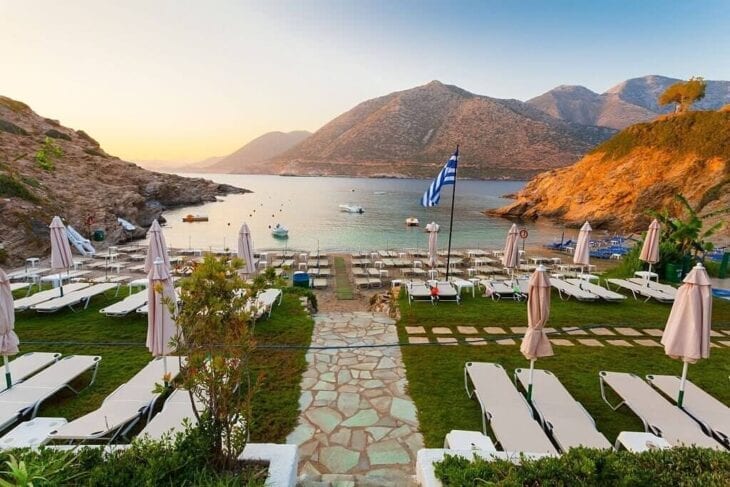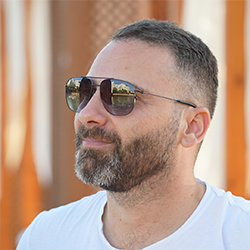Rethymno Crete: Things to do, Beaches, Travel Guide and Car Rental
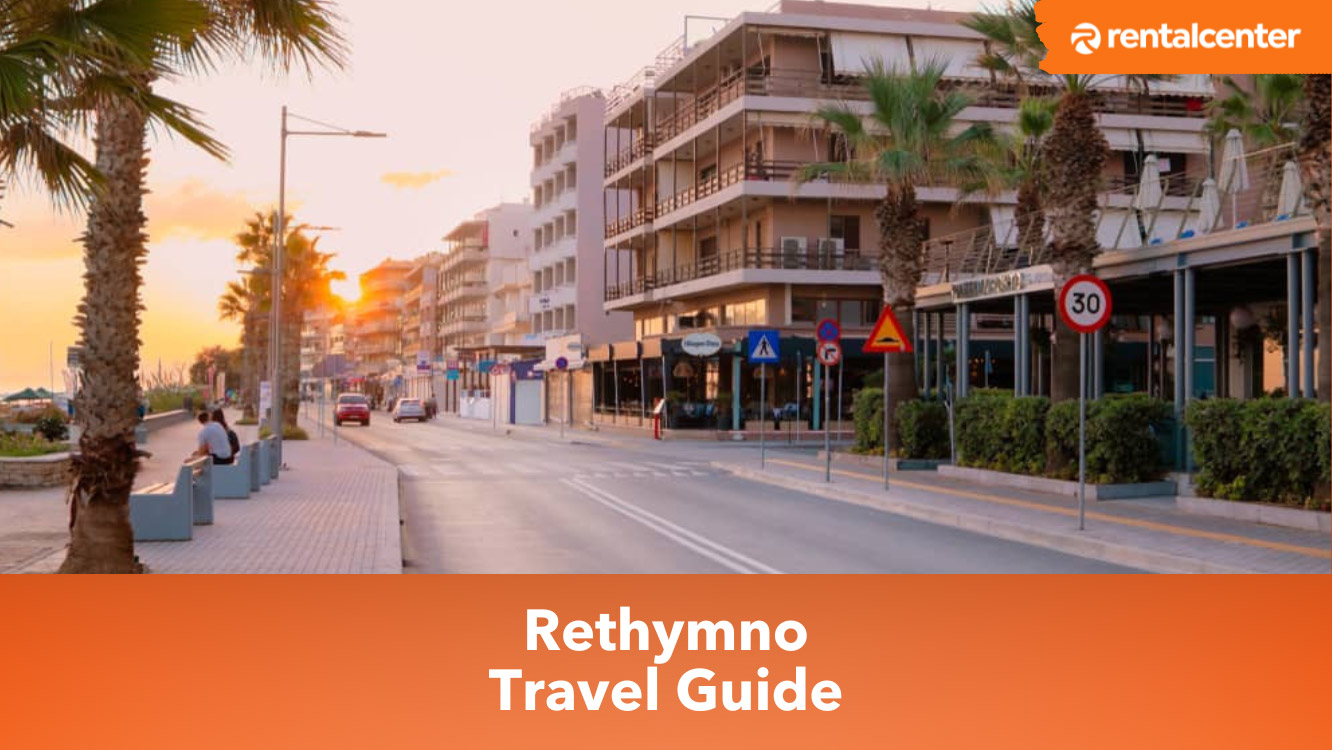
Rethymno, a city in Crete, Greece, offers a history and culture. Visitors can explore the well-preserved Venetian-era old town, Renaissance-style buildings and the iconic Fortezza fortress. The city features numerous attractions, including the Archaeological Museum of Rethymno, showcasing artifacts from the Neolithic to Roman periods and the Rethymno Old Town, with its atmosphere and traditional architecture. Other notable sites include the Neratze Mosque, Arkadi Monastery and nearby gorges like Myli and Kourtaliotiko. Car rental is a convenient option for exploring Rethymno and its surroundings. Several rental companies operate within the city, offering various vehicles at different price points. Visitors typically need a valid driver’s license credit card to rent a car and meet minimum age requirements. Factors to consider when renting include insurance coverage, fuel policies and potential additional driver fees. Rethymno’s proximity to other popular destinations, such as Chania and Heraklion, makes it an ideal starting point for discovering Crete.
What is Rethymno?
Rethymno (Greek: Ρέθυμνο, pronounced “REH-them-no”) is a city and municipality located on the northern coast of Crete, Greece. It is the capital of the Rethymno regional unit and the third-largest city on the island, with a population of 34,000 people. Rethymno is known for its well-preserved Venetian-era old town, which features a harbor, narrow streets and Renaissance-style buildings. The name “Rethymno” is believed to have originated from the ancient Greek word “rithymna”, meaning “sandy”, referring to the long, sandy beach that stretches along the city’s coastline. During the Venetian occupation of Crete (13th-17th centuries), Rethymno flourished as a center of trade and culture and many of the city’s most iconic landmarks, such as the Fortezza (fortress) and the Rimondi Fountain, date back to this period. Rethymno is a popular tourist destination, blending history, culture and modern amenities. Visitors can explore the old town, relax on the sandy beaches and enjoy the nightlife. The city also hosts several cultural events, including the Renaissance and Cretan Diet Festival, celebrating the region’s rich history and culinary traditions.
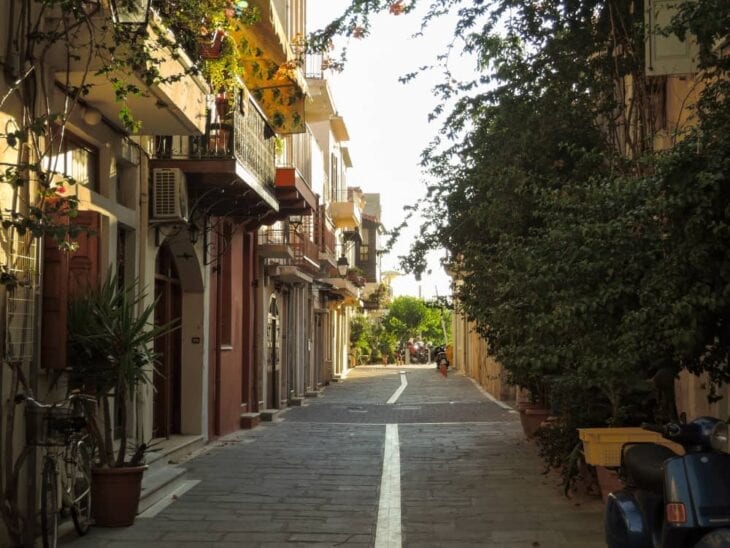
Where is Rethymno located?
Rethymno is located on the northern coast of Crete, Greece, between the island’s two largest cities, Chania and Heraklion. The town is built along a sandy coastline, with the Cretan Sea to the north and the Psiloritis Mountains to the south. Rethymno is 65 kilometers (40.4 miles) east of Chania, Crete’s second-largest city, known for its beautiful Venetian harbor and old town. Traveling between the two cities takes about an hour by car via the New National Road (E75). To the west of Rethymno, 99.4 kilometers (61.8 miles), lies the town of Kissamos, a popular starting point for exploring the beaches and rugged landscape of western Crete. To the east of Rethymno, 80 kilometers (49.7 miles) away, lies Heraklion, Crete’s capital and largest city. Heraklion is home to the famous Minoan Palace of Knossos and the Heraklion Archaeological Museum, which houses an extensive collection of Minoan artifacts. Traveling between Rethymno and Heraklion takes 1 hour and 15 minutes by car via the New National Road (E75).
How to get to Rethymno Crete?
Visitors arriving at Heraklion International Airport (HER), located 80 kilometers (50 miles) east of Rethymno, have several transportation options. The most convenient way is to rent a car from one of the many car rental agencies at the airport and drive to Rethymno via the New National Road (E75), which takes 1 hour and 15 minutes. Car rental prices range from €35 ($38.1, £30.4) to €65 ($70.8, £56.5) per day, depending on the season and provider. Visitors can take a taxi from the airport directly to Rethymno, which costs €100 ($109, £87) to €120 ($131, £104). For those on a budget, there are frequent public buses from Heraklion to Rethymno, with tickets costing €10 ($11, £9) to €12 ($13, £10) per person. The journey takes 1 hour and 30 minutes, depending on traffic and the number of stops.
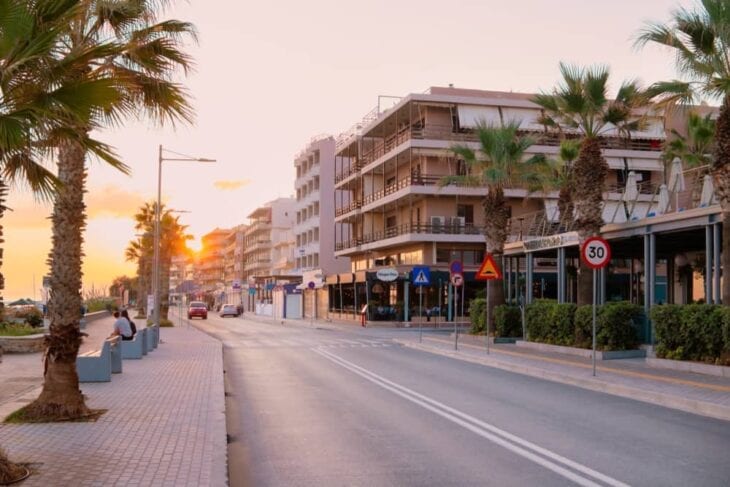
Visitors arriving at Chania International Airport (CHQ), located 71.9 kilometers west of Rethymno, have several transportation options. The most convenient way is to rent a car from one of the many car rental agencies at the airport and drive to Rethymno via the New National Road (E75), which takes around 1 hour. Car rental prices range from €30 ($32.7, £26.1) to €60 ($65.4, £52.2) per day, depending on the season and provider. Visitors can take a taxi from the airport directly to Rethymno, which costs €80 ($87, £70) to €100 ($109, £87). For those on a budget, there are regular public buses from Chania to Rethymno, with tickets costing €8 ($9, £7) to €10 ($11, £9) per person. The journey takes 1 hour and 15 minutes, depending on traffic and the number of stops.
Visitors arriving at Sitia Public Airport (JSH), located 204 kilometers east of Rethymno, have several transportation options. The most convenient way is to rent a car from one of the car rental agencies at the airport and drive to Rethymno via the European route E65 and then the New National Road (E75), which takes 2 hours and 15 minutes. Car rental prices vary depending on the season and provider, ranging from €40 ($43.6, £34.8) to €70 ($76.3, £60.9) per day. Visitors can take a taxi from the airport directly to Rethymno, which costs €180 ($196, £157) to €200 ($218, £174). For those on a budget, there are public buses from Sitia to Rethymno, but the journey involves a change of buses in Heraklion and takes 4-5 hours. Tickets cost €20 ($22, £17) to €25 ($27, £22) per person.
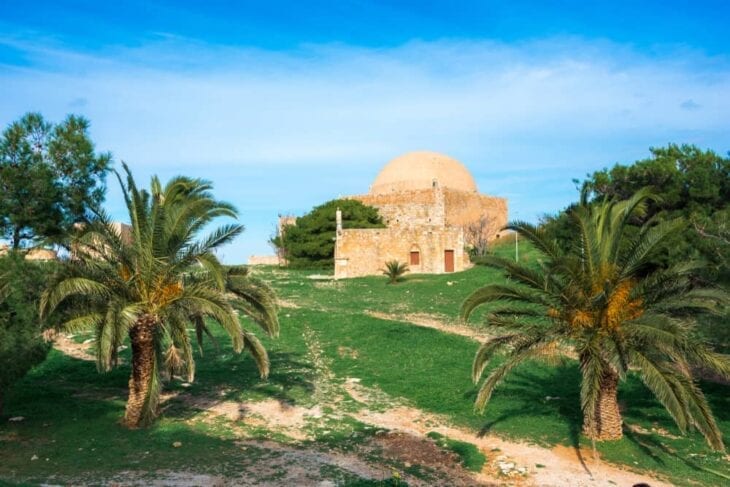
What are the best beaches near Rethymno?
Rethymno, a city on the northern coast of Crete, Greece, offers a variety of beaches for visitors to explore. There are options from Rethymno Beach in the city center to the secluded Preveli Beach near the Kourtaliotiko Gorge for every preference. Accessibility ranges from easy walks to driving on winding roads. Visitors can enjoy these beaches free of charge, with some offering rentals for sunbeds and umbrellas.
- Rethymno Beach: Rethymno Beach, located in Crete, Greece, offers kilometers of sandy coastline with a promenade and various amenities. Visitors enjoy complimentary access to swimming, sunbathing and recreational activities, with options to rent sunbeds and umbrellas.
- Karavostasis Beach: Karavostasis Beach near Bali village in Crete is renowned for its long stretch of sand and pebbles, surrounded by scenic cliffs and olive groves. Visitors can enjoy swimming and snorkeling in the clear waters of this cove.
- Panormos Beach: Panormos Beach, located in Panormos village, Crete, lures visitors with its vast sandy expanse and shallow waters. Easily accessible by car or bus, it’s a family-friendly destination with ample amenities like sunbeds and water sports facilities.
- Plakias Beach: Plakias Beach in Plakias, Crete, offers a scenic escape with its long shoreline and calm waters. Easily reached by car or bus, it provides free admission and various amenities like sunbeds and beach volleyball courts.
- Preveli Beach: Preveli Beach, near Preveli village in Crete, features a secluded setting at the mouth of Kourtaliotiko Gorge. Accessible by car or boat, it offers free admission but limited facilities, encouraging visitors to bring their essentials.
1. Rethymno Beach
Rethymno Beach is located in Rethymno, Crete, Greece. It is a stretch of sand extending several kilometers along the city’s northern coast. The Cretan Sea borders the beach to the north and a promenade with palm trees, shops and restaurants to the south. The width of the beach varies, but it averages 50 meters (164 feet) from the shoreline to the promenade. Rethymno Beach is located directly in front of the city of Rethymno, on the northern coast of Crete, 80 kilometers (50 miles) west of Heraklion and 60 kilometers (37 miles) east of Chania. The beach is easily accessible from anywhere in the city, as it runs parallel to the main coastal road. Visiting Rethymno Beach is free, with no entrance fees or costs for access. Visitors can freely swim, sunbathe and engage in other recreational activities. The beach is well-organized, with sunbeds and umbrellas available for rent, water sports facilities and beach volleyball courts. The distance from the center of Rethymno city to Rethymno Beach is 1 kilometer (0.6 miles). Visitors can reach the beach on foot by walking along the coastal promenade, which takes 10-15 minutes. They can use public transportation or drive and park in one of the many parking areas near the beach. The main beach of the town is one of the best beaches to visit in Rethymno.
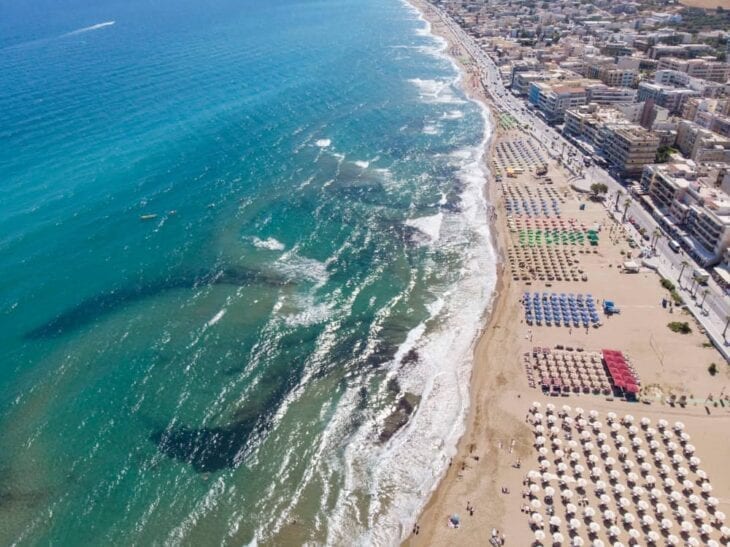
2. Karavostasis Beach
Karavostasis Beach is located near the village of Bali, Crete, Greece. It is a long, narrow beach that is composed of a mix of sand and pebbles. The beach is in a cove surrounded by rocky cliffs and hills covered in olive groves and tamarisk trees. The waters at Karavostasis Beach are straightforward and relatively shallow, making it a popular spot for swimming and snorkeling. Karavostasis Beach is 33 kilometers (20.5 miles) east of Rethymno city, along the northern coast of Crete. It is located just east of the village of Bali and is accessible by car via a paved road from the main coastal highway. Visiting Karavostasis Beach is free of charge, with no entrance fees or costs for access. The beach has some facilities, including sunbeds and umbrellas available for rent and a few nearby tavernas and cafes that offer refreshments and basic amenities. Visitors can reach the beach by driving along the main coastal highway that leads east from Rethymno and then turning north onto the road that leads to Bali. The drive takes 30-40 minutes, depending on traffic conditions. Visitors can take a public bus from Rethymno to Bali and then walk or take a taxi to the beach, which is located just east of the village center.
3. Panormos Beach
Panormos Beach is located in the village of Panormos, Crete, Greece. It is a vast, sandy beach stretching several hundred meters along the island’s northern coast. The beach is in a bay surrounded by rocky cliffs and hills covered in olive groves and pine trees. The waters at Panormos Beach are clear and shallow, making it a popular spot for families with children. Panormos Beach is 20 kilometers (12 miles) east of Rethymno city, along the northern coast of Crete. It is located in the center of the village of Panormos and is easily accessible by car or public transportation. Visiting Panormos Beach is free, with no entrance fees or costs for access. The beach is well-organized, with plenty of sunbeds and umbrellas for rent, water sports facilities and beach volleyball courts. Several tavernas, cafes and shops nearby offer refreshments and basic amenities. The distance from Rethymno City to Panormos Beach is 20 kilometers (12 miles). Visitors can reach the beach by driving along the central coastal highway east of Rethymno, which takes 20-30 minutes, depending on traffic conditions. Visitors can take a public bus from Rethymno to Panormos, which runs several times daily during summer. The beach is just a few meters from the bus stop in the center of the village.
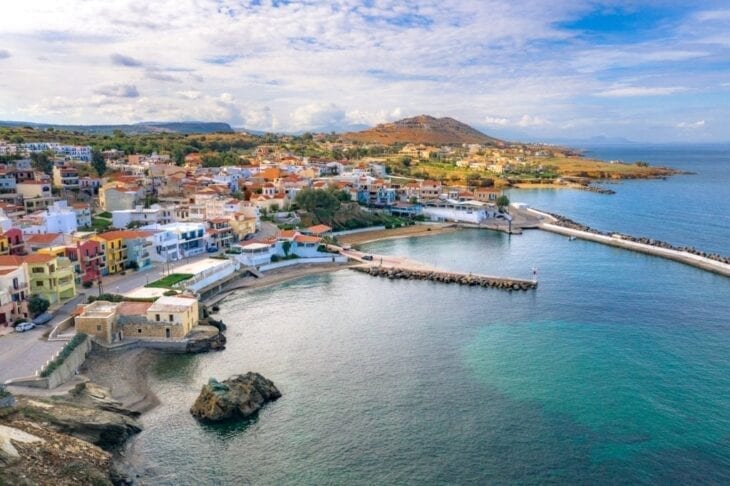
4. Plakias Beach
Plakias Beach is located in the village of Plakias, Crete, Greece. It is a long, wide beach stretching over 1 kilometer (0.6 miles) along the island’s southern coast. The beach is composed of fine sand and pebbles and is backed by cliffs and hills covered in olive groves and tamarisk trees. The waters at Plakias Beach are straightforward and relatively calm, making it a popular spot for swimming and sunbathing. Plakias Beach is 38.2 kilometers (23.74 miles) south of Rethymno city, along the southern coast of Crete. It is located in the center of the village of Plakias and is easily accessible by car or public transportation. Visiting Plakias Beach is free of charge, with no entrance fees or costs for access. The beach is well-organized, with plenty of sunbeds and umbrellas for rent, water sports facilities and beach volleyball courts. There are also several tavernas, cafes and shops located nearby that offer refreshments and basic amenities. Visitors can reach the beach by driving along the main road south of Rethymno, which takes 40-50 minutes, depending on traffic conditions. Visitors can take a public bus from Rethymno to Plakias, which runs several times daily during summer.
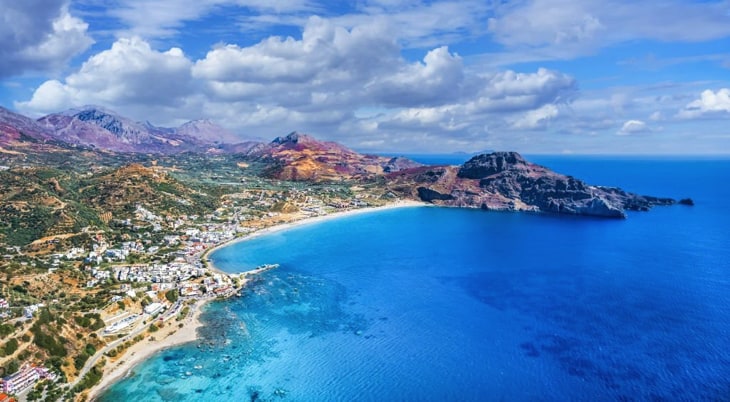
5. Preveli Beach
Preveli Beach is located near the village of Preveli, Crete, Greece. It is a small, secluded beach at the mouth of the Kourtaliotiko Gorge, where the Megalopotamos River meets the Libyan Sea. The beach is composed of fine pebbles and is surrounded by high cliffs and vegetation, including palm trees and oleander bushes. The waters at Preveli Beach are calm and clear, fed by the river that flows into the sea. Preveli Beach is 37.1 kilometers (23.1 miles) south of Rethymno city, along the southern coast of Crete. It is located near the village of Preveli and is accessible by car via a winding road that leads down to the beach from the main highway. Visiting Preveli Beach is free of charge, with no entrance fees or costs for access. The beach has limited facilities, with no sunbeds or umbrellas available for rent. Visitors must bring their equipment and supplies, including food and water, as no tavernas or cafes are located at the beach. Some facilities are located at the nearby Preveli Monastery, which is located on a hill overlooking the beach. Visitors can reach the beach by driving along the main road that leads south from Rethymno and then turning off onto the road that leads to Preveli. The drive takes 40-50 minutes, depending on traffic conditions. Visitors must then park their car at the designated parking area and walk down a steep path to reach the beach, which takes 10-15 minutes. Visitors can take a public bus from Rethymno to the village of Plakias and then take a taxi or hire a boat to reach the beach, located 5 kilometers (3 miles) east of Plakias.
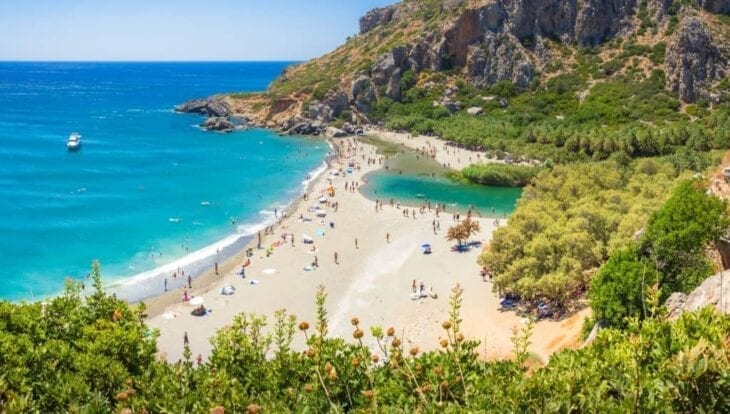
What are the best things to do in Rethymno?
Rethymno, a city on the northern coast of Crete, Greece, offers diverse attractions for visitors to explore. From the historic Venetian Fortezza Castle and the Archaeological Museum of Rethymno to the streets of the Old Town, there are plenty of cultural and architectural wonders to discover. Religious sites like the Arkadi and Preveli Monasteries provide insight into Crete’s spiritual heritage.
- Venetian Fortezza Castle: The Venetians erected Venetian Fortezza Castle, located in Rethimno 741 31, Greece, in the 16th century as a defense mechanism against Ottoman incursions. This fortress complex atop a hill encompasses structures like a church, a mosque and military quarters, encircled by robust stone walls and bastions.
- Archaeological Museum of Rethymno: The Archaeological Museum of Rethymno was established in 1887 and housed in Αγ. Φραγκίσκου, Rethymno 741 31, Greece, showcases artifacts from the Neolithic era to the Roman period in the Rethymno region. It features an array of exhibits, including pottery, sculptures, coins, jewelry and a selection of Minoan seals and sealings.
- Rethymno Old Town: Rethymno Old Town is a captivating historic enclave in Rethymno, Crete, Greece. It is renowned for its preserved Venetian and Ottoman architecture, meandering alleyways and ambiance. Entry to the Old Town is unrestricted and visitors enjoy shopping and dining experiences.
- Neratze Mosque: Neratze Mosque, also identified as Gazi Hussein Mosque, graces Emmanoil Vernardoy 2, Rethymno 741 31, Greece, a testament to the Ottoman era’s architectural legacy. Modest attire and shoe removal are prerequisites for entry. Guided tours are offered at €20 ($21.80, £17.40) per group.
- Petres Gorge: Petres Gorge is a natural wonder in Rethymno, Crete, Greece. It is carved by the meandering Petres River as it converges into the Cretan Sea. Spanning 5 kilometers (3.11 miles) with depths plunging up to 100 meters (328.08 feet), the gorge enthralls adventurers with its narrow passages, cliffs and cascades.
- Myli Gorge: Myli Gorge, known as Mili Gorge, is in Rethymno, Crete, Greece. It is a verdant sanctuary characterized by the meandering Myli River and vegetation comprising plain trees and oleander bushes. Stretching 3 kilometers (1.86 miles) in length, this gorge offers a relatively moderate hiking trail compared to its counterparts.
- Arkadi Monastery: Arkadi Monastery, a testament to Cretan resilience against Ottoman dominance, graces the landscape of Rethymno, Crete, Greece, atop a plateau near Amnatos village. Entry to Arkadi Monastery, priced at €3 ($3.27, £2.61) per person, grants access to its premises, church and museum, with guided tours available for €20 ($21.80, £17.40) per group. Accessible via a southeastward journey from Rethymno, visitors can embark on a scenic drive or opt for public transportation to reach this historic landmark.
- Preveli Monastery: An emblem of resistance against Ottoman rule, Preveli Monastery, perched on the southern coast of Crete, Greece, offers a look into its storied past and scenic vistas of the Libyan Sea and Preveli’s Palm Beach. Founded in the 16th century, this monastery complex beckons visitors to explore its church, museum and cliffside setting free of charge.
- Anogia Village: Anogia Village, a cultural enclave in the Psiloritis Mountains of Rethymno, Crete, Greece, captivates visitors with its traditional architecture, folklore and artisanal heritage. Entry to Anogia Village is unrestricted, allowing visitors to peruse its quaint streets and artisanal shops at leisure.
- Spili Village: Spili Village, a hamlet in Rethymno, Crete, Greece, distinguished by its Venetian-style architecture and natural springs, entices visitors with its artisanal offerings. Located 30 kilometers (18.64 miles) southeast of Rethymno, amidst the verdant foothills of the Psiloritis Mountains, this village serves as a gateway to scenic landscapes and cultural experiences.
- Agia Galini: Agia Galini, a coastal village on the southern shores of Crete, Greece, captivates visitors with its harbor, sandy beaches and tavernas overlooking the Libyan Sea. Accessible via a leisurely drive or public transportation, Agia Galini invites travelers to unwind and indulge in its laid-back atmosphere.
1. Venetian Fortezza Castle
Venetian Fortezza Castle is a fortress in Rethimno 741 31, Greece. The Venetians built it in the 16th century to protect the city from Ottoman attacks. The fortress consists of a complex of buildings, including a church, a mosque and military barracks, surrounded by thick stone walls and bastions. Venetian Fortezza Castle is located on a hill overlooking the city of Rethymno and the Cretan Sea. It is located in the center of Rethymno, 2.5 kilometers (1.55 miles) from the Old Town and the Venetian Harbor. Visiting Venetian Fortezza Castle requires the purchase of an entrance ticket, which costs €4 ($4.36, £3.48) per person. The ticket includes access to the fortress grounds, the church and the mosque. Guided tours of the fortress are also available for an additional fee of €30 ($32.70, £26.10) per group. The distance from the center of Rethymno to Venetian Fortezza Castle is 2.5 kilometers (1.55 miles). Visitors can reach the fortress on foot by walking uphill from the Old Town or the Venetian Harbor, following the signs for the Fortezza. The walk takes around 10-15 minutes, depending on the pace.
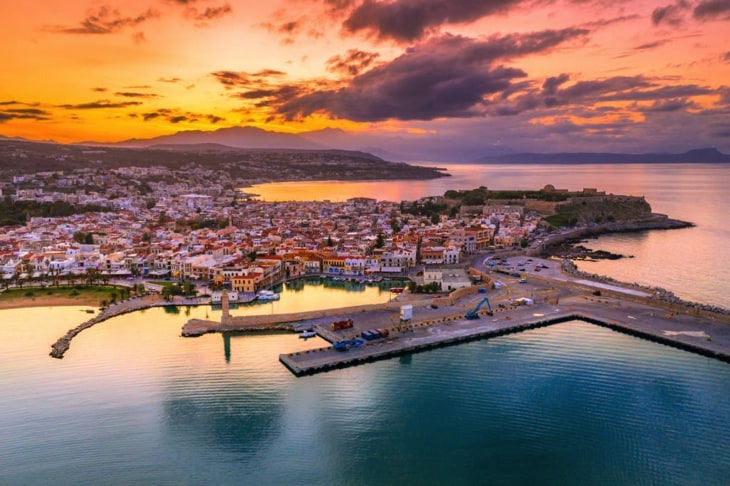
2. Archaeological Museum of Rethymno
The Archaeological Museum of Rethymno is a museum located in Αγ. Φραγκίσκου, Rethymno 741 31, Greece. It was founded in 1887 and houses a collection of artifacts from the Neolithic period to the Roman era in the Rethymno region. The museum exhibits include pottery, sculptures, coins, jewelry and a collection of Minoan seals and sealings.
The Archaeological Museum of Rethymno is located in the center of Rethymno, 2.2 kilometers (1.37 miles) from the Venetian Harbor and the Old Town. It is in a historic building on M. Vernardou Street, near the Municipal Garden. Visiting the Archaeological Museum of Rethymno requires the purchase of an entrance ticket, which costs €3 ($3.27, £2.61) per person. The ticket includes access to all the museum exhibits and collections. Guided museum tours are also available for an additional fee of €20 ($21.80, £17.40) per group. Visitors can reach the museum on foot by following the Venetian Harbor or Old Town museum signs. The walk takes 5-10 minutes, depending on the pace. They can take a taxi or a public bus to the museum, with tickets costing €1 ($1.09, £0.87) per person.
3. Rethymnon Old Town
Rethymnon Old Town is a historic district in Rethymno, Crete, Greece. It is known for its well-preserved Venetian and Ottoman architecture, narrow streets and lively atmosphere. The Old Town is a maze of alleys and squares lined with colorful houses, shops, cafes and restaurants. Rethymno Old Town is in the center of Rethymno, along the Venetian Harbor and the waterfront. It is 100 meters (0.06 miles) from the Venetian Fortezza Castle and the Archaeological Museum of Rethymno. Visiting Rethymno Old Town is free, with no entrance fees or costs for access. Visitors may wish to purchase goods or services from local shops and restaurants, with prices varying depending on the item or service. Guided tours of the Old Town are also available for €30 ($32.70, £26.10) per group. The distance from the center of Rethymno to Rethymno Old Town is 100 meters (0.06 miles). Visitors can reach the Old Town on foot by walking from the Venetian Harbor or the Fortezza Castle, following the signs for the Old Town. The walk takes around 2-5 minutes, depending on the pace.

4. Neratze Mosque
Neratze Mosque, also known as Gazi Hussein Mosque, is located in Emmanoil Vernardoy 2, Rethymno 741 31, Greece. It was built in the 17th century during the Ottoman rule of Crete and is one of the few surviving mosques in Rethymno. The mosque features a distinctive minaret, a dome and a courtyard with a fountain. Neratze Mosque is in the center of Rethymno, within the Old Town district. It is located on Ethnikis Antistaseos Square, 2.2 kilometers (1.37 miles) from the Venetian Harbor and the Rimondi Fountain. Visiting Neratze Mosque is free of charge, with no entrance fees or access costs. Visitors must dress modestly and remove their shoes before entering the mosque. Guided tours of the mosque are available for a fee of €20 ($21.80, £17.40) per group. Visitors can reach the mosque on foot by walking from the Venetian Harbor or the Rimondi Fountain, following the signs for the mosque. The walk takes 5-10 minutes, depending on the pace. Visitors can take a taxi or a public bus to the mosque, with tickets costing €1 ($1.09, £0.87) per person.
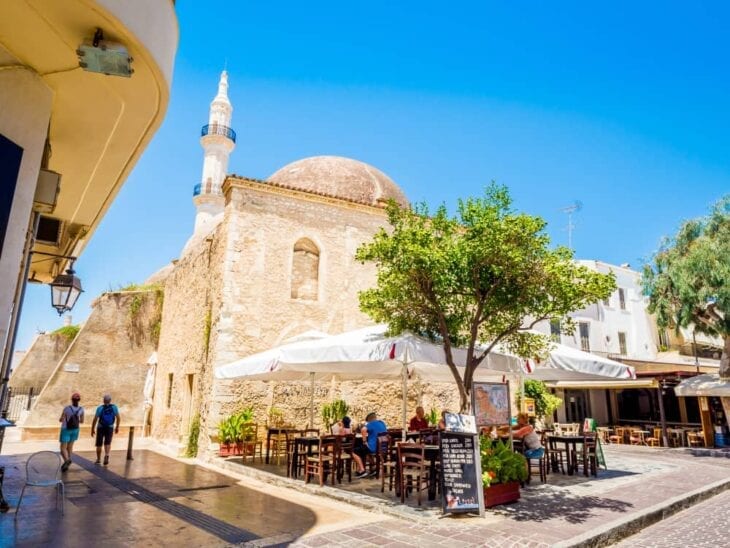
5. Petres Gorge
Petres Gorge is a gorge in Rethymno, Crete, Greece. It is formed by the Petres River, which flows through the gorge and empties into the Cretan Sea. The gorge is known for its narrow passages, cliffs and waterfalls. It measures 5 kilometers (3.11 miles) in length and reaches depths of up to 100 meters (328.08 feet). Petres Gorge is located in the northern part of Rethymno, near the village of Petres. It is 15 kilometers (9.32 miles) east of the city and 40 kilometers (24.85 miles) west of Heraklion. The gorge is part of the broader network of gorges in the Rethymno region, which includes the Myli Gorge and the Kourtaliotiko Gorge. Visiting Petres Gorge is free, with no admission or access fees. Some local tour operators offer guided hikes through the gorge, with prices starting from €30 ($32.70, £26.10) per person. Visitors must be prepared for a challenging hike through the gorge, which requires good physical fitness and appropriate hiking gear. The hike through the gorge typically takes 3-4 hours to complete. The distance from Rethymno city to the starting point of the Petres Gorge hike is 20.6 kilometers. Visitors can reach the trailhead by driving east from Rethymno along the main highway and then turning off onto the road leading to the Petres village. From there, signs and markers indicate the beginning of the hiking trail through the gorge.
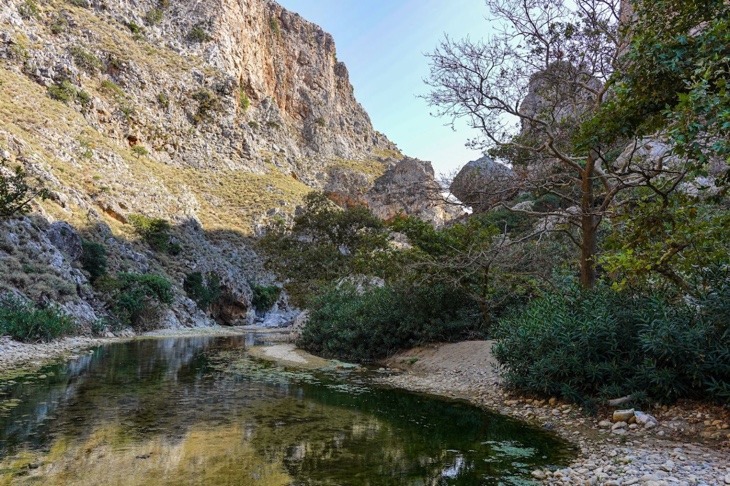
6. Myli Gorge
Myli Gorge or Mili Gorge, is in Rethymno, Crete, Greece. The Myli River, which flows through the gorge and empties into the Cretan Sea forms it. The gorge is known for its vegetation, including plane trees, oleander bushes and wild herbs. It measures 3 kilometers (1.86 miles) long and is relatively easy to hike compared to other gorges in the region. Myli Gorge is located just east of the city of Rethymno, near the village of Chromonastiri. It is located 5 kilometers (3.11 miles) east of the center of Rethymno and 35 kilometers (21.75 miles) west of Heraklion. The gorge is easily accessible from Rethymno and is a popular destination for nature lovers and hikers. Visiting Myli Gorge is free, with no admission or access fees. Some local tour operators offer guided hikes through the gorge, with prices starting from €20 ($21.80, £17.40) per person. The gorge is well-maintained and has a marked hiking trail, making it suitable for visitors of all ages and fitness levels. The hike through the gorge typically takes 1-2 hours to complete, depending on the pace. The distance from Rethymno city to the starting point of the Myli Gorge hike is 5 kilometers (3.11 miles). Visitors can reach the trailhead by driving east from Rethymno along the main highway and then turning off onto the road leading to Chromonastiri village. From there, signs and markers indicate the beginning of the hiking trail through the gorge. Visitors can take a public bus from Rethymno to Chromonastiri, with tickets costing €2 ($2.18, £1.74) per person and then walk to the trailhead, which is located just a few hundred meters (0.12 miles) from the village center.
7. Arkadi Monastery
Arkadi Monastery is a monastery located in Rethymno, Crete, Greece. It was built in the 16th century and is known for its role in the Cretan resistance against the Ottoman Empire. The monastery consists of a complex of buildings, including a church, a museum and monks’ quarters, surrounded by a thick stone wall. Arkadi Monastery is located on a plateau in the Rethymno region, 19.4 kilometers (12.05 miles) southeast of Rethymno. It is located near the village of Amnatos, in a scenic area overlooking the surrounding hills and valleys. Visiting Arkadi Monastery requires the purchase of an entrance ticket, which costs €3 ($3.27, £2.61) per person. The ticket includes access to the monastery grounds, church and museum. Guided tours of the monastery are also available for an additional fee of €20 ($21.80, £17.40) per group. The distance from Rethymno city to Arkadi Monastery is 23 kilometers (14.29 miles). Visitors can reach the monastery by driving southeast from Rethymno along the main highway, following the signs for Arkadi. The drive takes 30-40 minutes, depending on traffic conditions. Visitors can take a public bus from Rethymno to the village of Amnatos, with tickets costing €3 ($3.27, £2.61) per person and then walk or take a taxi to the monastery, which is located 2 kilometers (1.24 miles) from the village.
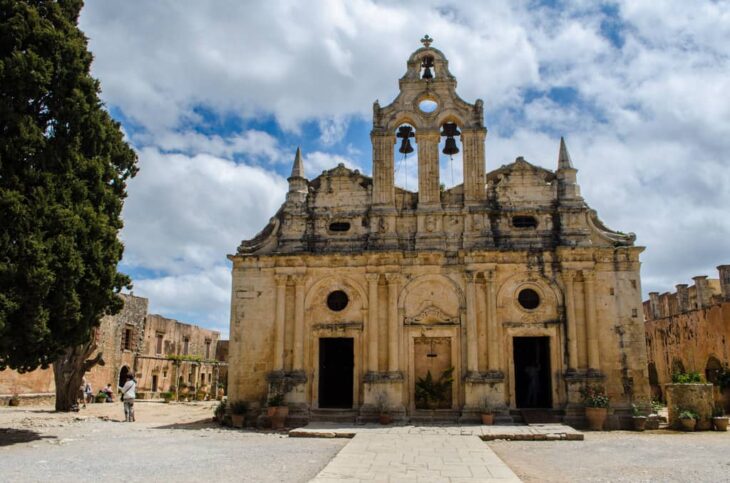
8. Preveli Monastery
Preveli Monastery is a monastery in Rethymno, Crete, Greece. It was founded in the 16th century and is known for its role in the Cretan resistance against the Ottoman Empire. The monastery consists of a complex of buildings, including a church, a museum and monks’ quarters, located on a cliff overlooking the Libyan Sea and the famous Palm Beach of Preveli. Preveli Monastery is situated on the southern coast of Crete, 35 kilometers (21.75 miles) south of the city of Rethymno. It is located near the village of Preveli, in a scenic area overlooking the sea and the surrounding mountains. Visiting Preveli Monastery is free, with no admission or access costs. Visitors must dress modestly and behave respectfully while on the monastery grounds. Guided tours of the monastery are available for a fee of €30 ($32.70, £26.10) per group. The distance from Rethymno city to Preveli Monastery is 35 kilometers (21.75 miles). Visitors can reach the monastery by driving south from Rethymno along the main highway, following the signs for Preveli. The drive takes around 45-60 minutes, depending on traffic conditions. Visitors must then follow a narrow road to the monastery, which can be challenging for some vehicles. Visitors can take a public bus from Rethymno to the village of Plakias, with tickets costing €4 ($4.36, £3.48) per person and then take a taxi or hire a boat to reach the monastery, which is located 5 kilometers (3.11 miles) east of Plakias.
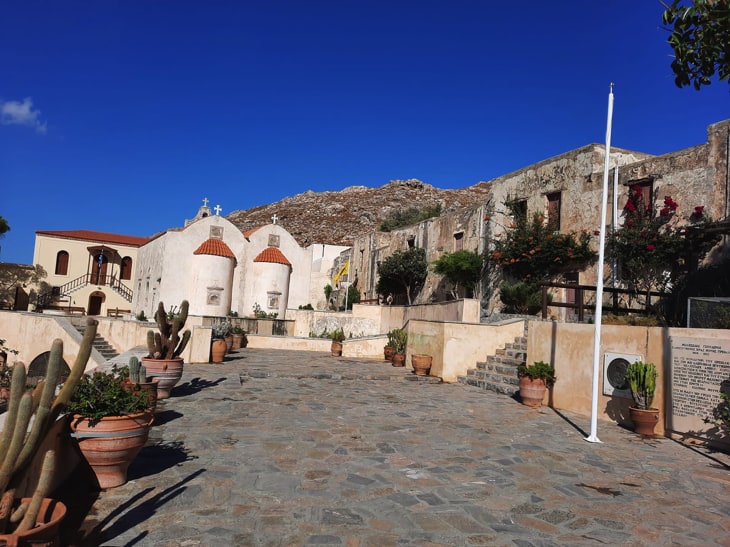
9. Anogia Village
Anogia Village is located in the Rethymno region, Crete, Greece. It is known for its traditional architecture, folklore and textile production. The village has narrow streets and alleys lined with stone houses and shops selling handmade crafts and local products.
Anogia Village is in the Psiloritis Mountains, 54.3 kilometers (33.7 miles) southeast of Rethymno. It is 740 meters (2,427.82 feet) above sea level and offers views of the surrounding mountains and valleys. Visiting Anogia Village is free of charge, with no entrance fees or costs for access. Visitors may wish to purchase local products or crafts from the village shops, with prices varying depending on the item. Guided tours of the village are also available for a fee of €50 ($54.50, £43.50) per group. The distance from Rethymno city to Anogia Village is 50 kilometers (31.07 miles). Visitors can reach the village by driving southeast from Rethymno along the main highway, following the signs for Anogia. The drive takes 1 hour, depending on traffic conditions. Visitors can take a public bus from Rethymno to Anogia, with tickets costing €5 ($5.45, £4.35) per person.
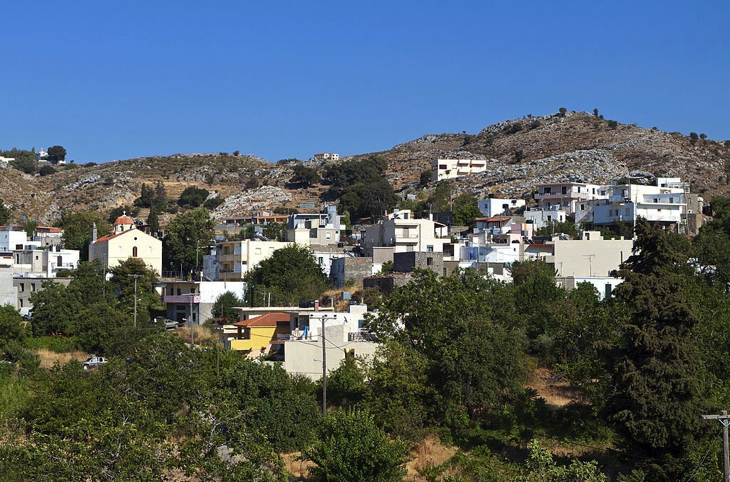
10. Spili Village
Spili Village is located in the Rethymno region, Crete, Greece. It is known for its Venetian-style architecture, traditional crafts and natural springs. The village is a central square with a large fountain, surrounded by cafes, shops and houses with colorful doors and windows. Spili Village is in the foothills of the Psiloritis Mountains, 30 kilometers (18.64 miles) southeast of the city of Rethymno. It is 430 meters (1,410 feet) above sea level in a fertile valley known for its olive groves and vineyards. Visiting Spili Village is free of charge, with no entrance fees or costs for access. Visitors may wish to purchase local products or crafts from the village shops, with prices varying depending on the item. Guided tours of the village and the surrounding area are also available for €40 ($43.60, £34.80) per group.
The distance from Rethymno City to Spili Village is 30 kilometers (18.64 miles). Visitors can reach the village by driving southeast from Rethymno along the main highway, following the signs for Spili. The drive takes 40-50 minutes, depending on traffic conditions. Visitors can take a public bus from Rethymno to Spili, with tickets costing €4 ($4.36, £3.48) per person.
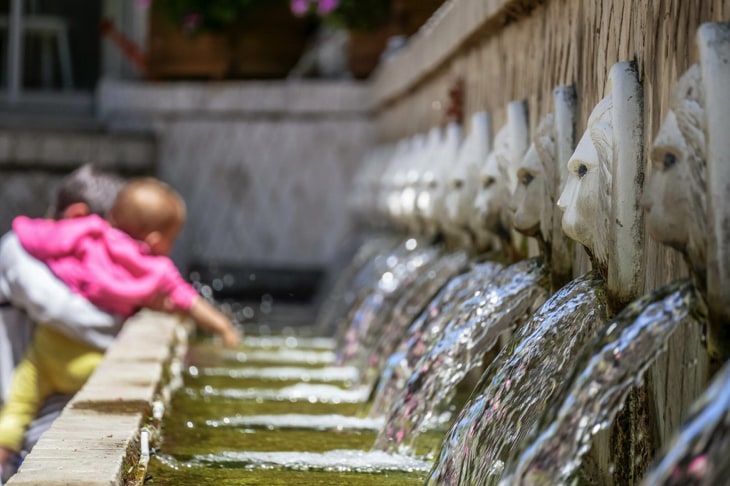
11. Agia Galini
Agia Galini is a village on the southern coast of Crete, Greece. It is known for its harbor, beaches and tavernas. The town has narrow streets and alleys lined with white-washed houses and shops selling local products and crafts. Agia Galini is in Rethymno, 55.3 kilometers (34.3 miles) southeast of Rethymno. It is located on a hill overlooking the Libyan Sea, at the mouth of the Platys River. Visiting Agia Galini is free, with no admission or access fees. Visitors may wish to purchase goods or services from local shops and restaurants, with prices varying depending on the item or service. Guided tours of the village and the surrounding area are also available for a fee of €50 ($54.50, £43.50) per group. Visitors can reach the town by driving southeast from Rethymno along the main highway, following the signs for Agia Galini. The drive takes 1 hour and 15 minutes, depending on traffic conditions. Visitors can take a public bus from Rethymno to Agia Galini, with tickets costing €7 ($7.63, £6.09) per person.
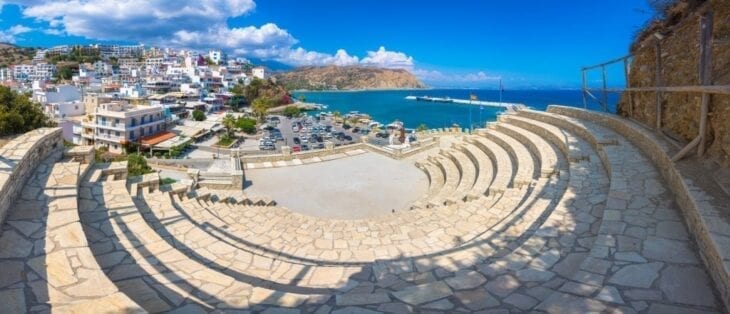
12. Plakias
Plakias is a village on the southern coast of Crete, Greece. It is known for its long sandy beach, crystal-clear waters and water sports facilities. The town has a main street lined with shops, restaurants, cafes and a promenade along the beach. Plakias is in the Rethymno region, 36 kilometers (22.37 miles) south of the city. It is in a bay surrounded by mountains and cliffs, offering views of the Libyan Sea. Visiting Plakias is free, with no admission or access fees. Visitors may wish to purchase goods or services from local shops and restaurants, with prices varying depending on the item or service. Water sports equipment and activities, such as snorkeling, diving and kayaking, are free, starting from €20 ($21.80, £17.40) per person. The distance from Rethymno city to Plakias is 36 kilometers (22.37 miles). Visitors can reach the village by driving south from Rethymno along the main highway, following the signs for Plakias. The drive takes around 45 minutes, depending on traffic conditions. Visitors can take a public bus from Rethymno to Plakias, with tickets costing €4 ($4.36, £3.48) per person.
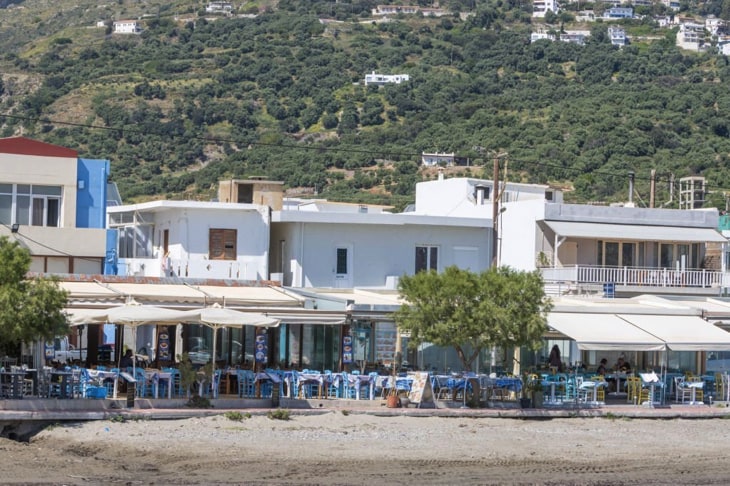
What is the history of Rethymno?
Crete is home to a legendary Bronze Age civilization- the Minoans. This complex civilization flourished in Crete for six centuries (2000 BC – 1400 BC). The region of Rethymnon is full of Minoan history. The city of Rethymnon (then Rithymna) was powerful enough even to mint its coins. Rethymno holds a significant place in Crete’s history. Evidence suggests the area was inhabited as early as the Minoan period, with archaeological discoveries shedding light on the city’s ancient roots. Rethymno was a vital trade and cultural exchange center during the Hellenistic and Roman eras. The city experienced a golden age under Venetian rule from the 13th to the 17th century, leaving an indelible mark on its architecture and urban planning. The Venetians fortified the city with impressive defensive structures, including the Fortezza fortress. Rethymno faced periods of conflict and changing rulers, including the Byzantines, Genoese and Ottomans, each leaving their imprint on the city’s cultural fabric. The Ottoman era, lasting from the 17th to the late 19th century, saw the construction of mosques, public baths and other buildings that blended with the existing Venetian architecture, creating a unique fusion of styles. In 1913, Rethymno, along with the rest of Crete, was united with Greece, marking the end of foreign rule and the beginning of a new chapter in the city’s history.
Is Rethymno nice?
Yes, Rethymno is nice to visit. It offers a well-preserved Venetian structure that is a testament to Rethymno’s strategic importance throughout history. Visitors can explore the city’s museums, which showcase the region’s cultural heritage and artifacts from various eras. Rethymno is lined with tavernas, cafes and shops, creating a lively and inviting ambiance. The long sandy beach, stretching along the city’s coastline, attracts locals and tourists for sunbathing, swimming and water sports. Rethymno offers a range of accommodation options, from budget-friendly hotels and apartments to luxurious resorts. The city’s dining scene caters to diverse tastes, with traditional Greek tavernas serving local Cretan cuisine and international restaurants offering various culinary experiences.
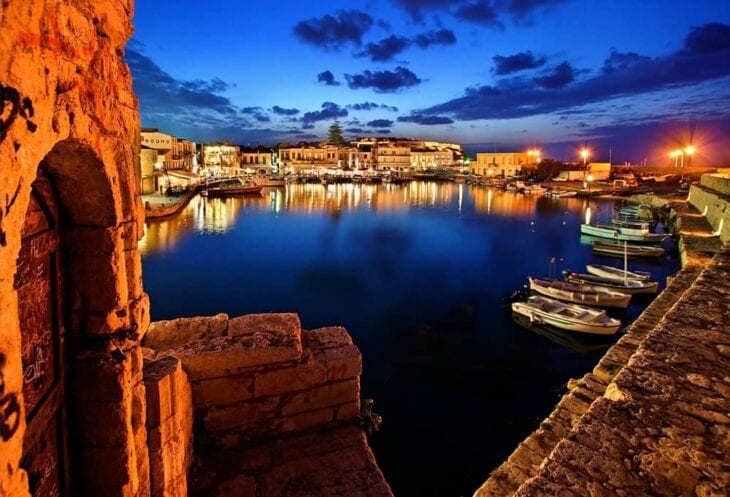
Is Rethymno suitable for a family vacation?
No, Rethymno is not suitable for a family vacation. Although it offers historical attractions and cultural experiences, its infrastructure and amenities cater more to other travelers. The city needs more extensive family-friendly facilities like designated playgrounds, large parks and kid-focused entertainment options. Rethymno’s narrow streets and limited parking spaces can challenge navigating with children. Families seeking a more relaxed and child-centered environment may find other locations in Crete better suited to their needs.
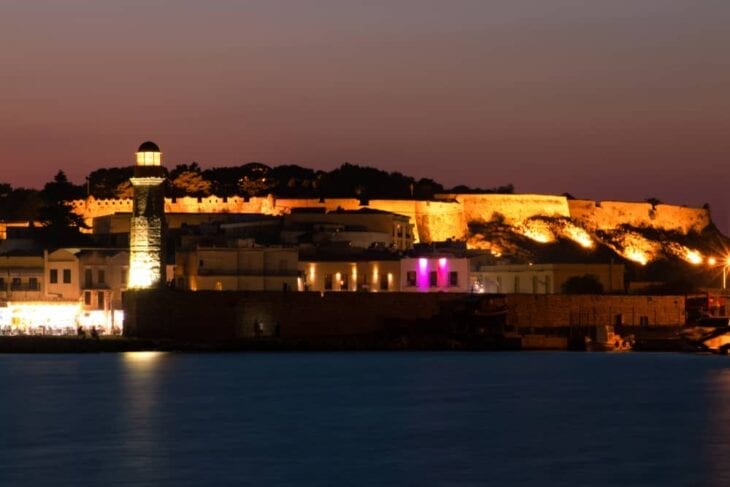
Is Rethymno suitable for a party vacation?
Yes, Rethymno is suitable for a party vacation. The city features a nightlife scene catering to visitors looking for entertainment and revelry. Rethymno’s old town district has numerous bars, clubs and pubs that come alive after dark. Establishments like Fortezza, Wolverine and The Blue Bar offer various music genres, from traditional Greek tunes to contemporary hits, ensuring a diverse party experience. The city’s beachfront areas also feature lively beach clubs and bars, providing the perfect setting for drinking, dancing and socializing.
Is there a good nightlife in Rethymnon?
Yes, there is good nightlife in Rethymnon. Rethymno offers an exciting and diverse nightlife scene, attracting party-goers worldwide. The city’s old town district is a hub of activity, with narrow streets lined with bars, clubs and pubs. Establishments like Fortezza, a popular nightclub in a former Venetian fortress, offer multiple dance floors and a lively atmosphere. Wolverine, another well-known club, features various music genres and themed nights. For those seeking a more relaxed vibe, pubs like The Blue Bar and The Bombay provide cozy settings for drinks and socializing. The city’s beachfront areas also offer nightlife, with numerous beach clubs and bars lining the coastline. Visitors can enjoy cocktails, live music and dancing at Bahamas and Renga Beach venues.
What are the best places to have a drink in Rethymno?
Find below the best places to have a drink in Rethymno.
- Metropolis Bar Rethymno: Metropolis Bar Rethymno is located at Nearchou 15-17, Rethymno 741 50, Greece, right in the center of Rethymno. The bar features a stylish interior, an extensive cocktail menu and a great selection of music played by talented DJs. Metropolis Bar Rethymno often hosts themed events and parties, making it a popular spot for locals and tourists. Prices are reasonable, with cocktails from €8 ($8.68, £6.93). Google’s rating is 4.7/5 and TripAdvisor’s rating is 4.5/5.
- Queens Room Club Restaurant: Queens Room Club Restaurant is located at Eleftheríou Venizélou 11, Rethymno 741 00, Greece, just a short 400-meter (0.25 miles) walk from the center of Rethymno. The restaurant serves delicious Greek and international cuisine, while the nightclub features a spacious dance floor, impressive lighting and a state-of-the-art sound system. Queens Room Club Restaurant hosts various events and theme nights, attracting a diverse crowd. Prices are moderate, with an average cost of €20 ($21.73, £17.30) per person for a meal and drinks. Google’s rating is 4.2/5 and TripAdvisor’s rating is 4.0/5.
- Store 311: Store 311 is located at Eleftheríou Venizélou 73, Rethymno 741 31, Greece, a short 1.2 kilometers (0.75 miles) walk from the center of Rethymno. The bar features a cozy interior, outdoor seating and a great selection of beers, cocktails and spirits. Store 311 regularly hosts live music events and themed nights, attracting a loyal following of music enthusiasts. Prices are affordable, with drinks from €5 ($5.43, £4.34). Google’s rating is 4.5/5 and TripAdvisor’s rating is 4.5/5.
- Lux Cafe: Lux Cafe is located at Eleftheríou Venizélou 65-68, Rethymno 741 31, Greece, just a short 190-meter (0.12 miles) walk from the center of Rethymno. The cafe features a stylish interior, comfortable seating and a lovely outdoor terrace. Lux Cafe serves a wide range of premium coffee, teas, delicious light bites and an impressive selection of cocktails and spirits. Prices are moderate, with drinks from €5 ($5.43, £4.34). Google’s rating is 4.5/5 and TripAdvisor’s rating is 4.5/5.
- BORA BORA: BORA BORA is located at Akrotiriou 8, Rethymno 741 00, Greece, a 1.5 kilometers (0.93 miles) walk from the center of Rethymno. The bar features comfortable sun loungers, colorful umbrellas and a great selection of refreshing drinks and cocktails. BORA BORA often hosts beach parties and events, with DJ sets and live music performances. Prices are reasonable, with drinks ranging from €6 ($6.52, £5.22) and sun loungers available for rent: Google rating 4.3/5 and Tripadvisor rating 4.0/5.
Can you walk from Rethymno to the nearest beach?
Yes, it is possible to walk from Rethymno to the nearest beach. The Rethymno Beach, also known as the Municipal Beach, is within city limits and is easily accessible on foot. The distance from the center of Rethymno to the nearest point of the beach is 1.5 kilometers (0.93 miles). The walk takes 20 minutes at a leisurely pace. From the old town area of Rethymno, visitors can follow the coastal road or take the pedestrian path along the seafront promenade, which runs parallel to the beach. The well-marked route provides views of the Cretan Sea and the town’s Venetian harbor. The Rethymno Beach stretches for several kilometers, offering ample space for sunbathing, swimming and other beach activities. The sandy beach has facilities such as umbrellas, sunbeds and beach bars available for rent. The water is generally calm and suitable for swimming, making it a popular destination for locals and tourists.
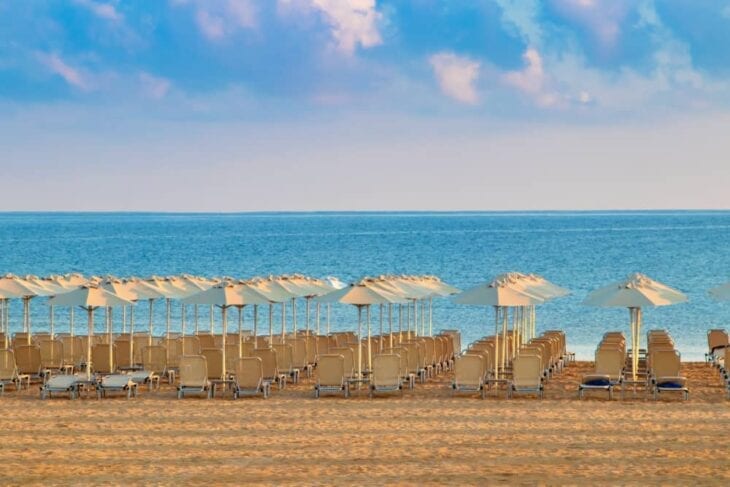
What are the best accommodations for staying in Rethymno?
Listed below are the best accommodations in Rethymno.
- Grecotel Creta Palace: Grecotel Creta Palace is located at Missiria, Rethymno 741 00, Greece, 4.3 kilometers (2.6 miles) from the center of Rethymno. The hotel features spacious rooms and suites, a private beach, multiple swimming pools, a spa and several dining options serving delicious local and international cuisine. With its extensive facilities and impeccable service, Grecotel Creta Palace is an ideal choice for a memorable stay in Rethymno. Prices typically start from €200 ($217.9, £174.3) per night, depending on the season and room type: Google rating 4.5/5 and Tripadvisor rating 4.5/5.
- BIO Suites Hotel Rethymnon: BIO Suites Hotel Rethymnon is at Svaitser 13, Rethymno 741 33, Greece, a short 1.2 kilometers (0.75 miles) walk from the center of Rethymno. This eco-friendly 4-star hotel offers modern and stylish suites with kitchenettes, perfect for short and extended stays. Guests can enjoy the hotel’s outdoor pool, fitness center and rooftop restaurant, which serves organic cuisine. Prices at BIO Suites Hotel Rethymnon typically start from €100 ($108.6, £86.8) per night, subject to seasonal fluctuations and room availability. Google’s rating is 4.6/5 and TripAdvisor’s rating is 4.5/5.
- Aquila Porto Rethymno: Aquila Porto Rethymno is located at Sofokli Venizelou 52, Rethymno 741 33, Greece, just 1.1 kilometers (0.68 miles) from the center of Rethymno. This 5-star beachfront hotel offers a perfect combination of luxury, comfort and convenience. The hotel features elegant rooms and suites, a private beach, indoor and outdoor pools, a spa and several dining options showcasing local and international flavors. Prices typically start from €150 ($163.5, £130.8) per night, depending on the season and room type. Google’s rating is 4.4/5 and TripAdvisor’s rating is 4.5/5.
- Thalassa Boutique Hotel: Thalassa Boutique Hotel is at Stamathioudaki 89, Rethymno 741 32, Greece, just a short 1.3 kilometers (0.8 miles) walk from the center of Rethymno. Guests can enjoy the hotel’s outdoor pool, sun terrace and on-site restaurant serving delectable Cretan cuisine. Prices at Thalassa Boutique Hotel typically start from €80 ($86.8, £69.5) per night, subject to seasonal fluctuations and room availability. Google’s rating is 4.3/5 and TripAdvisor’s rating is 4.5/5.
- Rimondi Boutique Hotel: Rimondi Boutique Hotel is located at Xanthoudidou 21, Rethymno 741 00, Greece, just a short 0.3 mile (500 meters) walk from the center of Rethymno. The elegant rooms and suites have high-end furnishings and a comfortable and stylish stay. Prices typically start from €120 ($131.7, £106.2) per night, depending on the season and room category selected. Google’s rating is 4.6/5 and TripAdvisor’s rating is 4.5/5. Rimondi Boutique Hotel is considered one of the best places to stay in Rethymno.
What are the best places to eat in Rethymno?
Listed below are the best places to eat in Rethymno.
- Achinos Rethymno: Achinos Rethymno is located at Arkadiou 188, Rethymno 741 00, Greece, a short 450-meter (510 yards) walk from the center of Rethymno. This restaurant offers a cozy and inviting atmosphere, serving traditional Cretan cuisine with a modern twist. The menu features fresh, locally sourced ingredients and a wide selection of dishes to suit every palate. Prices are reasonable, with an average cost of €15 ($16.4, £13.1) per person for a meal. Achinos is one of the top places to eat in Rethymno.
- Nostos: Nostos is located at Panos Kornaros 27, Rethymno 741 00, Greece, just a short 1.1 kilometers (0.68 miles) walk from the center of Rethymno. The menu showcases authentic Greek and Cretan dishes prepared with the finest ingredients and served with a creative flair. The attentive staff and excellent wine selection enhance the overall dining experience. Prices at Nostos are moderate, with an average cost of €20 ($21.9, £17.5) per person for a meal.
- Zefyros: Zefyros is located at Salaminos 5, Rethymno 741 00, Greece, just a short 900-meter (1,000 yards) walk from the center of Rethymno. The menu features an extensive selection of fresh fish and seafood dishes prepared with skill and passion. The friendly staff and relaxed atmosphere create a welcoming environment for guests to enjoy their meals. Prices at Zefyros are slightly higher than average, with an average cost of €25 ($27.3, £21.9) per person for a meal.
- Othonas: Othonas is located at Ethnikis Antistaseos 55, Rethymno 741 00, Greece, just a short 750-meter (820 yards) walk from the center of Rethymno. The menu features a delightful selection of Greek and Mediterranean dishes prepared with fresh, locally sourced ingredients. The attentive staff and excellent service make dining at Othonas a lovely experience. Prices are reasonable, with an average cost of €15 ($16.4, £13.1) per person for a meal.
- To Pigadi Restaurant: To Pigadi Restaurant is located at Titou Petichaki 18, Rethymno 741 00, Greece, a short 350-meter (380 yards) walk from the center of Rethymno. The menu showcases authentic Cretan and Greek cuisine, focusing on traditional recipes and flavors. The friendly staff and excellent wine selection enhance the overall dining experience. Prices at To Pigadi Restaurant are moderate, with an average cost of €20 ($21.9, £17.5) per person for a meal.
Where to shop in Rethymno?
There are several places to shop in Rethymno. Firstly, the old town is a shop with its narrow streets lined with boutiques, souvenir shops and local artisan stores. Visitors can find handmade crafts, traditional Cretan pottery, textiles and locally produced olive oil and wine. Secondly, Arkadiou Street is a popular destination for shopping enthusiasts. This pedestrian-friendly street is home to various shops, from international fashion chains to local specialty stores. Visitors can explore multiple products, including clothing, accessories and souvenirs. Thirdly, the Rethymno Central Market is a must-visit for those seeking a more modern shopping experience. This covered market offers various stalls selling fresh produce, spices, herbs and local delicacies. Lastly, the city’s outskirts are home to several shopping malls and retail parks, catering to those seeking a more contemporary shopping experience. These modern complexes feature popular international brands, department stores and a variety of dining options. Rethymno hosts several flea markets and street markets throughout the year.
Can you rent a car in Rethymno?
Yes, visitors can rent a car in Rethymno. Renting a car in Rethymno, Crete, is convenient for exploring the region at your own pace. Several rental companies operate within the city, offering various vehicles to suit different needs and budgets. Car renting is straightforward and most companies require a valid driver’s license and a credit card for the deposit. The leading rental companies have offices in the city center or near the airport and major hotels, ensuring easy accessibility. Most rental companies provide primary insurance coverage, but it is advisable to review the policy and opt for additional coverage if desired. Fuel costs in Crete can vary, but returning the car with a full tank is generally recommended to avoid excessive refueling charges.
What is the average cost to rent a car in Rethymno and Crete?
The cost of renting a car in Rethymno and the island of Crete can vary depending on several factors, including the rental company, the type of vehicle, the rental duration and the time of year. The average daily rate for a compact car or small economy vehicle ranges from €25 ($27.25, £21.75) to €45 ($49.05, £39.15) during the low season and from €35 ($38.15, £30.45) to €60 ($65.40, £52.20) during the high season. These prices are for a basic rental without any additional extras or insurance. If prefer a mid-size car or a standard sedan, the average daily rate can range from €30 ($32.70, £26.10) to €55 ($59.95, £47.85) in the low season and from €40 ($43.60, £34.80) to €70 ($76.30, £60.90) in the high season. For larger vehicles like SUVs, minivans or luxury cars, the average daily rate can be anywhere from €45 ($49.05, £39.15) to €80 ($87.20, £69.60) in the low season and from €60 ($65.40, £52.20) to €120 ($130.80, £104.40) in the high season. Most Rethymno car rentals offer discounts for extended rental periods, such as weekly or monthly rentals, which can significantly reduce the overall cost.
What are the requirements for renting a car in Rethymno?
Listed below are the requirements for renting a car in Rethymno.
- Valid driver’s license: Renters must possess a valid driver’s license from their country of origin. The license should be in the Latin alphabet or accompanied by an International Driving Permit (IDP) if it is in a non-Latin alphabet. Some rental companies may require the driver to have held their license for a minimum of 1-3 years.
- Minimum age requirement: Most car rental companies in Rethymno require drivers to be at least 21. Some companies may have a higher age requirement, especially for luxury or high-performance vehicles. Renters under 25 may be subject to additional fees or restrictions.
- Credit card: A valid credit card in the driver’s name is typically required for car rentals in Rethymno. The credit card secures a deposit and covers potential damages or additional fees. Some rental companies may accept debit cards, which are less common and may require further restrictions.
- Passport or government-issued ID: Renters must provide a valid passport or government-issued ID in Rethymno as proof of identity. This document will verify the renter’s personal information and ensure it matches their driver’s license and credit card details.
- Collision Damage Waiver (CDW) or insurance: Most car rental companies in Rethymno include a basic level of insurance, such as a Collision Damage Waiver (CDW), in their rental rates. Renters should carefully review the terms and conditions of the insurance policy to understand what is covered and what additional options may be available, such as theft protection or personal accident insurance.
- Fuel policy: Renters should know the company’s fuel policy in Rethymno. Most companies require the vehicle to be returned with the same amount of fuel as when it was picked up. Some may offer a “full-to-full” policy, where the renter is responsible for refueling the car before returning it. In contrast, others may charge a premium for a “full-to-empty” policy, allowing the renter to return the car without refueling.
- Additional drivers: If there is more than one driver, renters should inform the rental company when booking Rethymno. Additional drivers may be subject to extra fees and must meet the exact requirements as the primary driver, such as minimum age and possessing a valid driver’s license. Some companies may offer free additional driver options for spouses or domestic partners.
What should you consider before reserving a car rental in Rethymno?
Below are several factors to consider before reserving a car rental in Rethymno.
- Insurance: Before renting a car in Rethymno, travelers should carefully review the rental company’s insurance options. Most companies offer basic Collision Damage Waiver (CDW) coverage, which may not cover all potential damages. Additional insurance options, such as theft protection or personal accident insurance, may be available for an extra cost.
- Driver’s Age and Gender: Age and gender can impact car rental rates in Rethymno. Most companies require drivers to be at least 21 years old, with some imposing a higher age limit of 23 or 25 for specific vehicle types.
- Type of Car Needed: When choosing a rental car in Rethymno, travelers should consider the vehicle that best suits their needs. Factors to remember include the number of passengers, amount of luggage, fuel efficiency and the terrain they’ll be driving on. Smaller cars, such as a Fiat Panda or Nissan Micra, are ideal for couples or solo travelers, while larger groups may require a spacious sedan, SUV or minivan.
- Hotel Delivery: Some car rental companies serving Rethymno may offer hotel delivery services, allowing travelers to bring their vehicle directly to the village or nearby areas like Kalyves or Almyrida. This can be particularly convenient for those staying in the area, eliminating the need to travel to a rental office.
- One-way rental possibility: If travelers plan on flying out of Crete from a different location than Rethymno, such as Heraklion Airport or Chania International Airport (CHQ), they should inquire about one-way rental options. One-way rentals allow travelers to pick up their vehicle in Rethymno and return it at the airport or another designated location.
- Documents needed: Before reserving a car rental in Rethymno, travelers should ensure they have all the necessary documents. These typically include a valid driver’s license from their country of origin, a passport or government-issued ID and a credit card in the driver’s name. If the driver’s license is outside the Latin alphabet, an International Driving Permit (IDP) may be required to accompany it.
- Option to pick up at Crete’s Airport: For travelers arriving in Crete by air, picking up a rental car directly from the airport is convenient. Heraklion International Airport (HER) and Chania International Airport (CHQ) have several Crete car rental companies operating on-site, making it easy to collect a vehicle upon arrival.
How far is Rethymnon from Chania Old Town?
Rethymno and Chania Old Town, two of Crete’s most iconic destinations, are located along the island’s northern coast, separated by 66.1 kilometers (41.1 miles). The journey between these two cities takes around one hour by car, depending on traffic conditions. For those considering renting a car, the cost can range from €25 ($27.25, £21.75) to €60 ($65.4, £52.2) per day, depending on the vehicle type and rental company. Fuel costs should also be factored in, with an average of €1.80 ($1.96, £1.57) per liter for gasoline. An alternative option is to take a public bus, which runs regularly between Rethymno and Chania. The bus fare is inexpensive, typically €5 ($5.45, £4.35) for a one-way ticket. The journey time by bus can vary between 1.5 to 2 hours, depending on the number of stops and traffic conditions.
How far is Rethymnon from Almyrida?
Almyrida, a coastal village known for its beaches and relaxed atmosphere, is 50.7 kilometers (31.5 miles) east of Rethymno. The drive between these two destinations typically takes 30 minutes, depending on traffic conditions. For those renting a car, the cost for the short journey can range from €10 ($10.90, £8.70) to €20 ($21.80, £17.40), depending on the vehicle type and rental company. Fuel costs should also be considered, with an average of €1.80 ($1.96, £1.57) per liter for gasoline. Visitors can use the public bus service, which operates regularly between Rethymno and Almyrida. The bus fare is relatively affordable, usually €2 ($2.18, £1.74) for a one-way ticket. The bus journey takes 45 minutes to an hour, depending on the number of stops and traffic conditions.
How to get from Chania Airport to Rethymnon?
Below are the step-by-step guide on how to get from Chania Airport to Rethymnon:
- By Car: Renting a car is convenient for the journey from Chania Airport to Rethymno. The distance is 72 kilometers (45 miles) and the travel time is 1 hour and 15 minutes, depending on traffic conditions. Visitors can rent a car from the various rental companies at the airport or in nearby towns.
- By Taxi: Taxis are readily available at Chania Airport and can provide a direct transfer to Rethymno. The taxi fare for the 71.9-kilometer journey is typically around €80 ($87.20, £69.60) to €100 ($109.00, £87.00), depending on the taxi company and the time of day. Taxis offer a convenient and comfortable option, especially for those traveling with luggage or in a group.
- By Bus: Public buses operated by regional bus firm KTEL offer a cost-effective way to travel from Chania Airport to Rethymnon. The bus route covers 72 kilometers (45 miles) and takes 1 hour and 30 minutes, with a few stops. The bus fare is €5 ($5.45, £4.35) per person, making it an economical choice for budget-conscious travelers.
- By Private Transfer: Private transfer services offer a hassle-free and personalized option from Chania Airport to Rethymnon. These services typically arrange for a driver to meet passengers at the airport and transport them directly to their destination in Rethymno. The cost for a private transfer varies based on the number of passengers and the service provider but can range from €60 ($65.40, £52.20) to €120 ($130.80, £104.40) for the 71.9-kilometer journey.
- By Shared Shuttle: Shared shuttle services are another cost-effective way from Chania Airport to Rethymnon. These services operate on a set schedule and allow passengers to share the ride with others heading in the same direction. Depending on the service provider, the cost for a shared shuttle is typically €15 ($16.35, £13.05) to €25 ($27.25, £21.75) per person for the 71.9-kilometer journey.
- By Rideshare: Rideshare services like Uber or Freenow can be an alternative option from Chania Airport to Rethymnon. The cost of rideshare will depend on the service provider, vehicle type and current demand. Generally, the fare for the 72 kilometers (45 miles) journey can range from €50 ($54.50, £43.50) to €80 ($87.20, £69.60), depending on the circumstances.
Is there a medical center in Rethymno?
Yes, there is a medical center in Rethymno. It is home to a significant public medical facility called the Rethymnon General Hospital. Located at 17 Trandalidou Str. in Rethymno, Greece, near the municipal gardens, this full-service hospital offers comprehensive care with all primary clinical specialties, outpatient clinics, an intensive care unit and medical services throughout the Rethymnon prefecture. The telephone number for the Rethymnon General Hospital is +30 2831 342100 and their website is www.rethymnohospital.gr. Besides the General Hospital, Rethymno has several private medical facilities for residents and visitors. These include Rethymno Medical Assistance, a walk-in clinic, DIAGNOSIS RETHYMNOU Medical Diagnostic Centre and the Rethymno Medical Office, which is open seven days a week. With the major public hospital and these supplementary private clinics and diagnostic centers, Rethymno is well-equipped to handle various medical needs.
Is there a police station in Rethymno?
The city of Rethymno has a dedicated police headquarters overseeing law enforcement operations in the region. The Rethymno Police Headquarters is at 26 Iroon Polytechniou Street, 74100 Rethymno, Crete, Greece. The telephone number for this main police facility is +30 28310 88155. In addition to the central headquarters, there are also some smaller police stations and departments located throughout the Rethymnon area. This includes the Security Police Station of Geropotamos / Rethymno Perama, which can be reached at +30 28310 88189 and the Traffic Police of Rethymno, with a contact number of +30 28310 88166. While these supplementary stations handle specific areas like traffic or certain neighborhoods, the Rethymno Police Headquarters serves as the entire Rethymno region’s primary law enforcement command center. Residents can visit or contact this central police station for significant incidents or matters requiring a full-service police facility and resources.
Is Rethymno worth visiting?
Yes, Rethymno is undoubtedly a destination worth visiting for those exploring the island of Crete. Visitors can explore themselves in the city’s Venetian and Ottoman influences, evident in the architecture of the Old Town streets and fortified structures. The iconic Fortezza fortress is a testament to Rethymno’s storied past, providing views of the city and the Mediterranean Sea. Rethymno features beaches, such as the long sandy stretch of Rethymno Beach, which is perfect for relaxation and water activities. With its lively tavernas, traditional markets and friendly locals, the city creates an authentic and memorable experience.
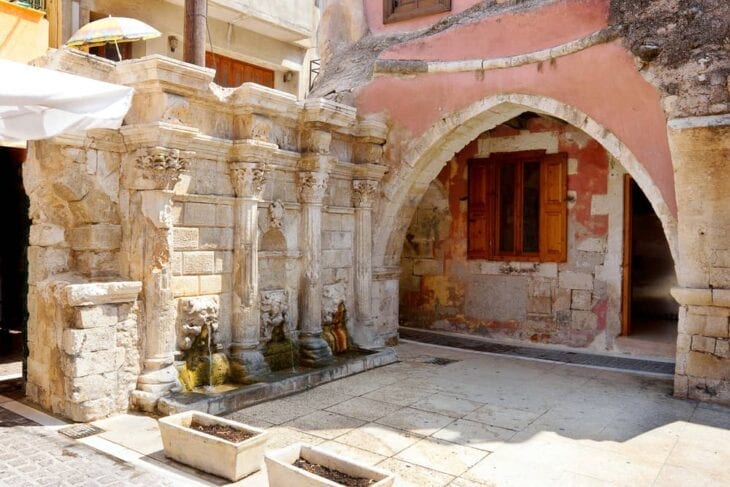
Is Rethymno expensive?
No, Rethymno is not expensive to visit. Rethymno and Crete is generally considered a budget-friendly destination, especially compared to some of Greece’s more popular and upscale destinations. Accommodation costs can vary greatly, with budget hotels and apartments starting from €40 ($43.60, £34.80) per night during the low season and €60 ($65.40, £52.20) per night during the high season. Mid-range options range from €60 ($65.40, £52.20) to €120 ($130.80, £104.40) per night, while luxury accommodations can cost upwards of €150 ($163.50, £130.50) per night. Dining costs are reasonable, with taverns offering traditional Cretan cuisine at affordable prices, often between €10 ($10.90, £8.70) and €20 ($21.80, £17.40) per person. Certain touristy areas may have slightly higher prices, but Rethymno is an excellent destination for budget-conscious travelers.
What is the best time to visit Rethymno?
The best time to visit Rethymno depends on personal preferences and desired activities. The peak season, from June to August, offers warm temperatures ranging from 25°C (77°F) to 32°C (90°F), making it ideal for beach-goers and outdoor enthusiasts. This is also the busiest and most expensive time. For those seeking milder weather and fewer crowds, April-May and September-October shoulder seasons are excellent choices. During these months, temperatures range from 18°C (64°F) to 25°C (77°F) and accommodation and flight costs are generally lower. The winter months, from November to March, are the coolest, with temperatures averaging between 10°C (50°F) and 16°C (61°F).
What are the best villages near Rethymno?
Listed below are the best villages near Rethymno.
- Anogia: Anogia, 56.3 kilometers (35 miles) from Rethymno, is a traditional Cretan village known for its rich history and cultural heritage. The town is famous for its skilled weavers, who create beautiful textiles using traditional techniques passed down through generations. Anogia is also renowned for its delicious local cuisine, featuring roasted lamb and handmade cheese dishes. Anogia is considered one of the top mountain villages to visit in Crete.
- Spili: Spili, located 26.7 kilometers (16.6 miles) from Rethymno, is a village in the foothills of the Kedros mountain range. The town is famous for its 25 Venetian-style lion-head fountains, which line the central square and provide fresh spring water to visitors and locals. The city is also home to several historic churches and monasteries, including the Monastery of Agios Rafail, which dates back to the 16th century.
- Margarites: Margarites, located 25.2 kilometers (15.7 miles) from Rethymno, is a small village renowned for its pottery tradition. The town has been a center of ceramic production since ancient times and visitors can watch skilled artisans create beautiful pottery pieces using traditional techniques. Margarites has numerous pottery workshops and shops where visitors can purchase unique handcrafted items as souvenirs.
- Agia Galini: Agia Galini, 51.9 kilometers (32.3 miles) from Rethymno, is a coastal village known for its beautiful beaches and crystal-clear waters. The village’s main beach is a popular spot for swimming, sunbathing and water sports, while the nearby Preveli Beach is famous for its palm tree forest and freshwater river. Agia Galini is also home to several ancient ruins, including the remains of a Minoan palace and a Roman villa.
- Plakias:: Plakias, located 34.3 kilometers (21.3 miles) from Rethymno, is a famous coastal village known for its long sandy beach and clear turquoise waters. The village’s beach is ideal for swimming, sunbathing and water sports, while the nearby Preveli Beach and Souda Beach offer more secluded and natural settings. Plakias is surrounded by natural scenery, including the Kourtaliotiko Gorge and the White Mountains, which provide excellent hiking and exploring opportunities.
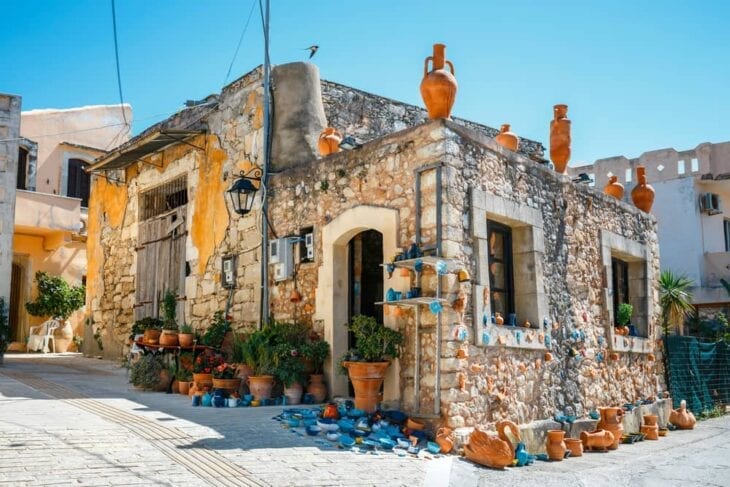
Last updated on January 5th, 2025








